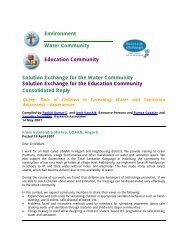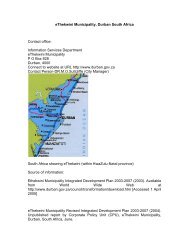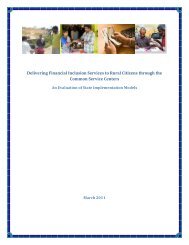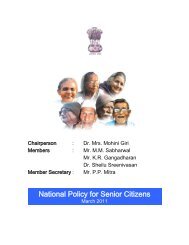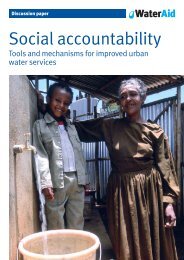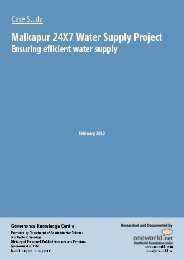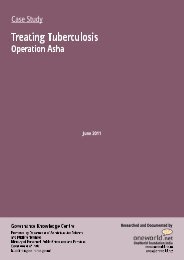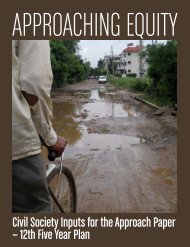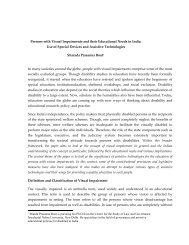EMRI model - Indiagovernance.gov.in
EMRI model - Indiagovernance.gov.in
EMRI model - Indiagovernance.gov.in
You also want an ePaper? Increase the reach of your titles
YUMPU automatically turns print PDFs into web optimized ePapers that Google loves.
Study of Emergency Response Service (<strong>EMRI</strong> Scheme)poor or the poorest and universal access systems have better chance of do<strong>in</strong>g so. Thisis a po<strong>in</strong>t that is controversial, for the reverse has also been argued; but if we add <strong>in</strong> thefact that there is a clear process of def<strong>in</strong><strong>in</strong>g a family as BPL and reach<strong>in</strong>g thatentitlement to the correct family, there would be a larger consensus on this op<strong>in</strong>ion.Thirdly, <strong>in</strong> a framework of right to health, the right to emergency medical care is one ofthe most basic of rights and a large public <strong>in</strong>vestment <strong>in</strong> this would be justified, evenwhile rem<strong>in</strong>d<strong>in</strong>g ourselves that that ERS (Emergency Response Service) is only a part ofEMS (Emergency Medical Service) and one needs larger <strong>in</strong>vestment <strong>in</strong> all of EMS, andnot only <strong>in</strong> the ERS component.Equity issues <strong>in</strong> utilization: However free service alone does not ensure access to thepoor. Geographic distances, social barriers and perceptions, levels of awareness and<strong>in</strong>formation with the public, outreach activities, <strong>in</strong>ability to <strong>in</strong>cur the associated out-ofpocketexpenses etc. will all limit access to the poor. If a disproportionate share of theservices is go<strong>in</strong>g to urban, centrally placed, economically better off, middle class section,the case for <strong>in</strong>creas<strong>in</strong>g state f<strong>in</strong>anc<strong>in</strong>g without additional alternative sources of f<strong>in</strong>anc<strong>in</strong>g,would become weaker. There is a need to monitor what is happen<strong>in</strong>g and there aresimply no structures <strong>in</strong> place to do so. There is a need for systematiz<strong>in</strong>g concurrentevaluation processes. The choice of provider for emergency medical care can also makeor break, even a middle class family without any <strong>in</strong>surance coverage. It couldsignificantly shift resources to the emergency medical care providers who get the largershare of referrals where there is <strong>in</strong>surance or patients mak<strong>in</strong>g more payments, make thechoice. There is alertness <strong>in</strong> <strong>EMRI</strong> to these problems, and any conflict of <strong>in</strong>terests or<strong>in</strong>formal tie ups that are noted, are strictly dealt with. However there is no positivestrategy of address<strong>in</strong>g these equity related issues. The <strong>gov</strong>ernment needs to<strong>in</strong>dependently monitor these aspects as well as articulate a strategy to manage theseissues.2. Cost<strong>in</strong>g of <strong>EMRI</strong> Services:1. Capital Costs: These work out to approximately Rs 11 lacs per ambulance. In all thethree projects the costs are high <strong>in</strong> the first year. It was Rs 21 lacs per ambulance <strong>in</strong>Andhra, Rs 28.27 lakhs <strong>in</strong> Gujarat and Rs 34.06 lakhs <strong>in</strong> Rajasthan. This higher firstyear costs is because the costs of build<strong>in</strong>g, adm<strong>in</strong>istration office , software, call centercosts that are <strong>in</strong>curred <strong>in</strong> the first year, when all ambulances are not <strong>in</strong> place. By thesecond year, these costs do not rise further but the number of ambulances <strong>in</strong>creases.The <strong>in</strong>creas<strong>in</strong>g first year capital cost across the three states represents ris<strong>in</strong>g nonambulancecapital costs as compared to the lower costs of procur<strong>in</strong>g and fitt<strong>in</strong>gambulances.2. The study does not have the <strong>in</strong>formation needed to comment on whether moreeconomies could have been made on these capital costs, or whether these are optimalcosts. However, clearly the project is itself <strong>in</strong> a learn<strong>in</strong>g curve as the rates be<strong>in</strong>gNational Health Systems Resource Centre (NHSRC)25



